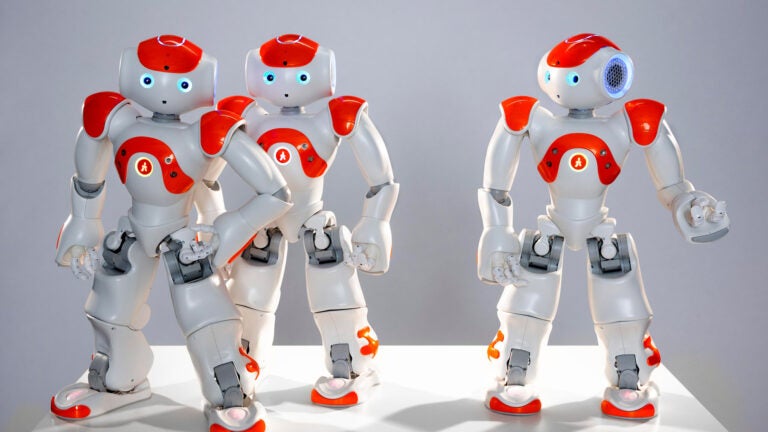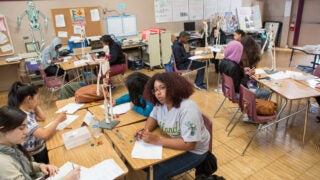
PHOTO BY LUKE FISHER
I, Robot
Children with autism relate to Maja Matarić’s ’bots
Maja Matarić couldn’t help but smile. A boy with autism stood in front of one of her Interaction Lab’s robots, looked at its mechanical face, and ordered, “Robot, say, ‘Choo-choo!’”
The robot stayed quiet.
“Oh, now I know how my teacher feels,” the boy said, displaying empathy both humorous and unexpected.
This is the kind of breakthrough that excites Matarić, USC professor and Chan Soon-Shiong Chair in Computer Science, Neuroscience and Pediatrics. She studies how socially assistive robots can help people, especially those with special needs. Among those who seem to benefit: children on the autism spectrum.
“No one knows why robots work so well with some children with autism. But we and others have observed repeatedly that when many children with autism interact with socially assistive robots, they show behaviors they ordinarily wouldn’t express, especially not with other people,” says Matarić, director of the USC Center for Robotics and Embedded Systems and co-director of the USC Robotics Research Lab.
Matarić’s lab conducts research with therapists and clinical researchers at Children’s Hospital Los Angeles, where she has placed robots to study how children on the autism spectrum relate to them as peers and playmates.
Matarić and her students are documenting everything from the essential challenges of autism to the kinds of interactions that children on the autism spectrum enjoy. Because many of these children respond well to repetition and predictability, and respond poorly to human faces and behaviors, robots may make ideal therapeutic play partners, she explains.
A small but growing group of researchers internationally are studying the use of robots in autism therapy, but Matarić’s work is unique in focusing on peer-like playmates similar in size and form to other children. The goal is to teach children with autism how to more easily interact with other people. Matarić was among those who created the Roadmap for U.S. Robotics, which resulted in the National Robotics Initiative, a presidential initiative that provides funding for robotics research. The National Science Foundation funds her long-term autism research.
“We are interested in how we can use robots to begin to change children’s behavior. What would happen if a child with autism had a robot buddy at school and at the playground—would that make other kids more interested in playing, and would the robot make the child more ready to play with other children?” Matarić says.
The work is gratifying to Patrick Soon-Shiong, who, with his wife, Michele B. Chan, endowed the chair Matarić holds at the USC Viterbi School of Engineering.
“We’re honored to be able to support work that could make a difference. With so many children diagnosed with autism today, we need tools to help them relate to others and embrace them into society,” Soon-Shiong says.
Certainly, Matarić takes a scientific approach to her research on the robots’ benefits to children with autism. Robots should never replace human therapists, she says. But, as a parent, she’s also enthusiastic and hopeful. If robotics technology improves and clinical trials proceed, she expects robots will be used to help certain children with autism within five years.
“For a spectrum disorder like autism, one magic pill isn’t going to happen,” she says. “If use of a robot is affordable and not damaging, why don’t we try it?”
Learn more about Matarić’s research or find out how you can advance this and other innovative research.



